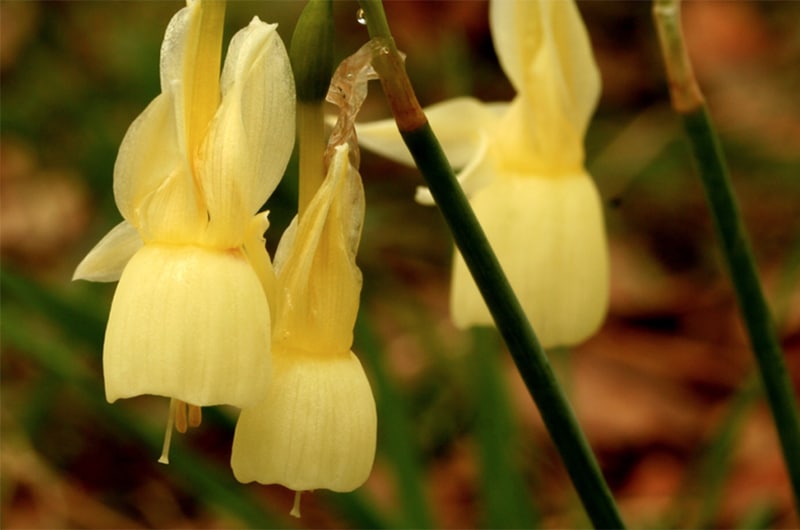Dr. Sarah Treanor Bois, Director of Research & Education at the Linda Loring Nature Foundation
The common daffodil, Narcissus sp., is a symbol of spring throughout North America. On Nantucket, we embrace the yellow blossom as a reminder that spring will (eventually) come to the island.

Beyond the fanfare of Siasconset and the antique car parade on Main Street, few of us reflect on what the daffodil plant actually is and where it came from. Milestone Road blooms yellow and white with the colorful flowers. These were planted by homeowners, Nantucket Land Bank staff, as well as countless boy scouts and other volunteers. They can be found naturalized in fields, lawn edges, roadsides, and other human-disturbed sites throughout southern New England. However, daffodils are not native to our region. Where in the world does the daffodil grow wild? Where has this plant evolved from?
First off, let’s talk about the plant itself. When we say “daffodil,” we are referring to species in the genus Narcissus which also includes paperwhites and tiandrus. These are perennial predominantly spring plants of the Amaryllis family. There are approximately 50 species of daffodils and with horticultural selection and breeding, there are thousands of cultivars of these species. When Carl Linnaeus was classifying species in the 1700s, he used “Narcissus” to describe the delicate, yellow flowers of these strong spring plants. The name comes from the youth of Greek mythology. Narcissus was a beautiful and vain young man who fell in love with his own reflection in a pool of water. He was so mesmerized that he fell into the pool, drowned, and, according to the tale, turned into a flower. I suppose on Nantucket we feed the Narcissus ego by dedicating a festival to the blossom named after him.
Well before Linnaeus, daffodil plants were known in ancient civilization and were introduced into gardens in about 300BC. The Greek botanist and philosopher Theophrastus listed and described many of the earliest known kinds of narcissus plants. Daffodils were brought to Britain by the Romans who thought that the sap from daffodils had healing powers. Actually the sap contains crystals that can irritate the skin.
All parts of the plant are actually poisonous, especially the bulb. In some cases, poisoning and even death have occurred when the bulbs were eaten after being mistaken for wild leeks. Their apparent bad taste and toxicity may be fortunate in some respects, however, as it means the deer generally avoid them.
Once the leaves die back in summer, the roots also wither. After some years, the roots shorten, pulling the bulbs deeper into the ground. The bulbs develop from the inside, pushing the older layers outwards which become brown and dry, forming an outer shell, the skin. Up to 60 layers of skin have been counted in some wild species.
After flowering, the daffodil leaves turn yellow and die back once the seed pod is ripe. The fruit capsule contains numerous seeds which are round and swollen with a hard coat. Most species have a total of 36 seeds, but some can have more. Seed dispersal in the wild is generally by wind or passively via passing animals and gravity.
The common daffodil is native to Western Europe, namely Spain, Portugal, western France, Morocco, and Italy. While Holland may come to mind, no bulb plant is actually native to Holland. However, it is the home of almost all the hybrids, since the Dutch hybridizers have not only created thousands of new flowers gardeners love, they’ve developed a huge national industry that supplies bulbs to gardeners worldwide. No members of the Narcissus genus (or the parent plant family) are native to North America, though they obviously do well in many of the gardens in our region.
It is important to understand that many of the original wild forms of these famous flowers look nothing like the garden flowers that hybridizers have created from them. The wild plants are generally smaller and paler than the many cultivars.
Some of the wild species are still available to grow in your own garden. Poet’s Daffodil (Narcissus poeticus), for example, is a white species with a flattened, but brilliant orange cup. This wild daffodil is an ancient one and was first described by Carl Linnaeus in the 1750s. Narcissus jonquilla, the jonquil or rush daffodil, is another wild daffodil native to Spain and Portugal. This
The Tenby daffodil (Narcissus pseudonarcissus ssp. obvallaris), a subspecies of the wild variety, grows wild across southwest Wales.
Today’s Dutch bulb industry is a true phenomenon in the world of horticulture. Nine billion flower bulbs a year are produced in Holland’s modern production fields today.
For a visual display of just some of the varieties of blossom shapes, colors, and sizes, check out the 44th Annual Community Daffodil Flower Show at Bartlett’s Farm over Daffodil Weekend (daffodilfestival.com).